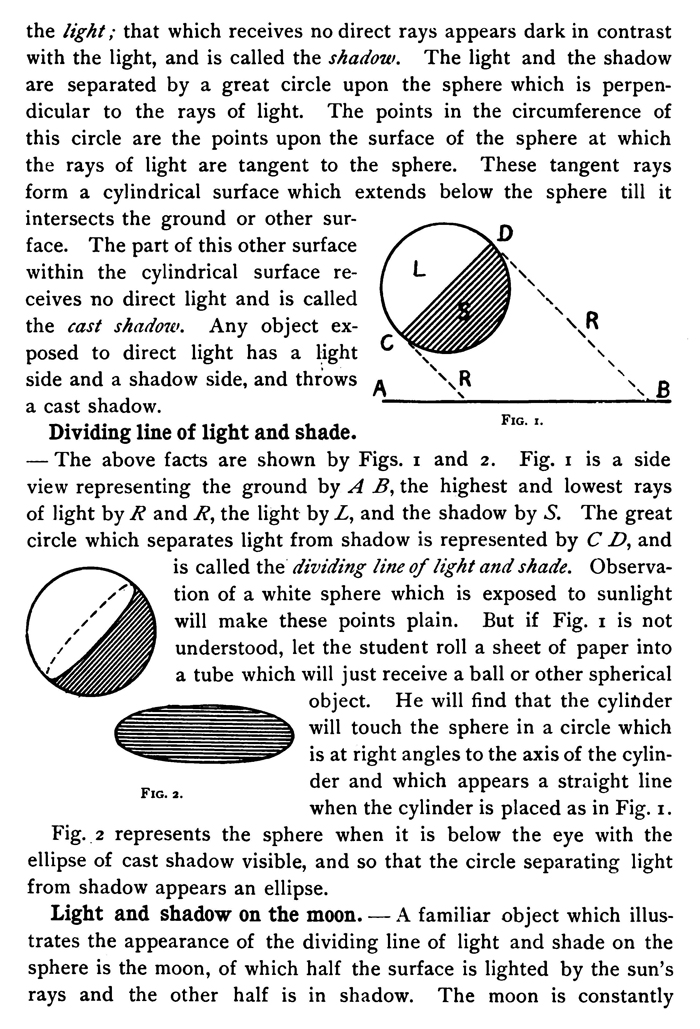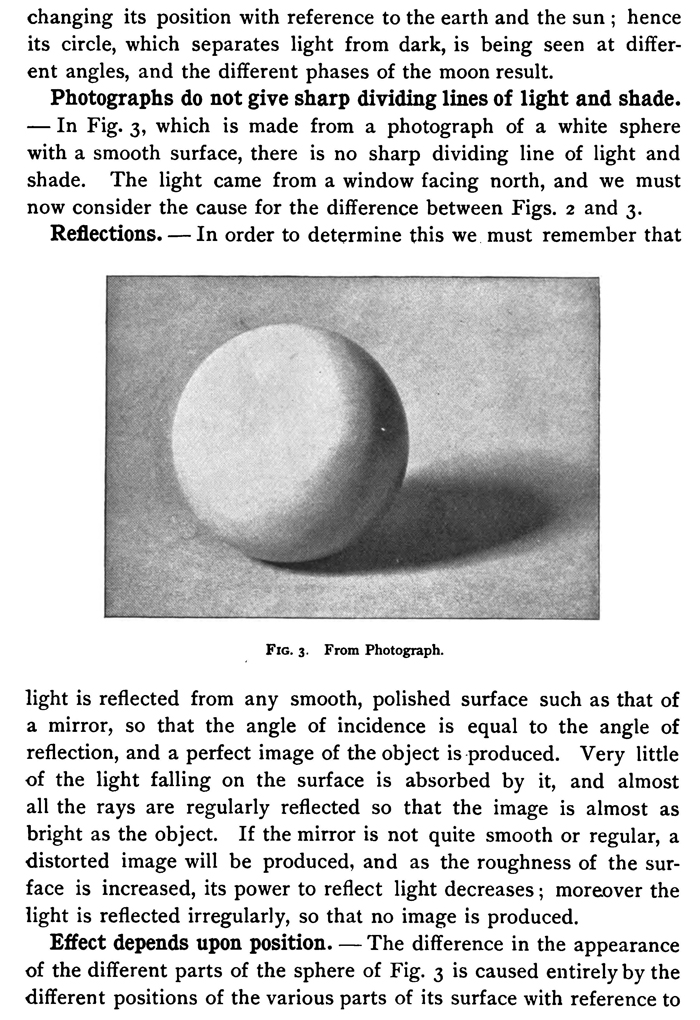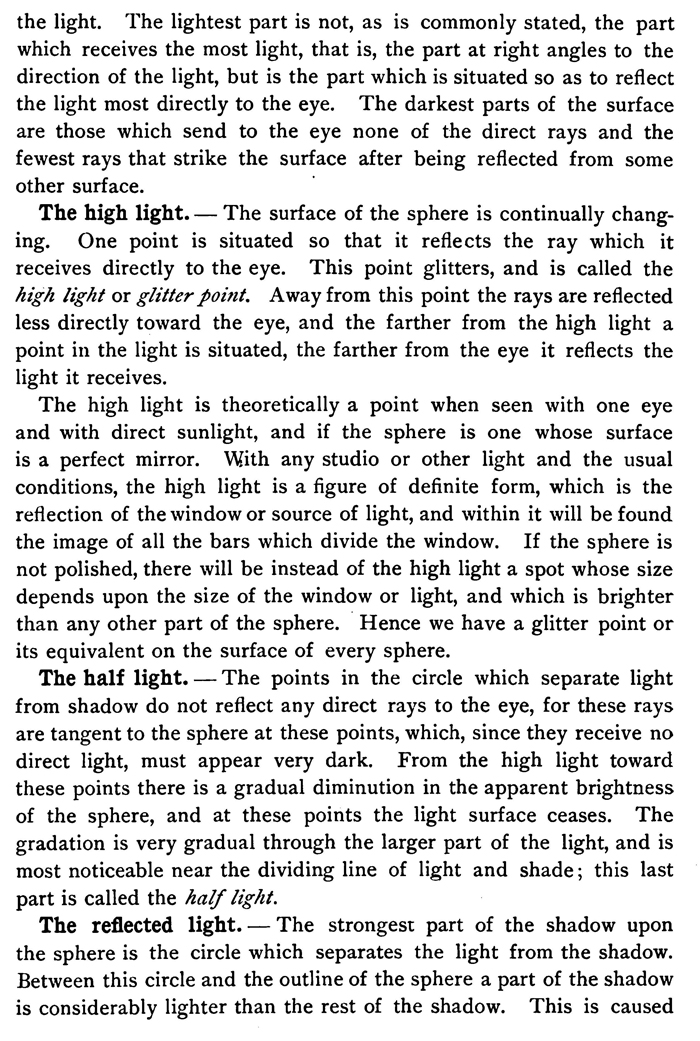
|

   
The Text Above are Images ... if You Need to Copy Text, You Can Do So Below. Thanks.
DRAWING THE SPHERE.
Sphere illustrates all light and shade contrasts.
We will study the effects of sunlight by means of the sphere, which is well adapted to present all the light and shade effects visible in nature.
Sunlight effects.
The rays of sunlight are straight, and diverge from the sun, but in the study of shadows are generally considered as parallel. One half of the surface of the sphere will then receive direct rays of light, and the other half will receive no direct rays. The half which receives the direct rays appears light, and is called
the light; that which receives no direct rays appears dark in contrast with the light, and is called the shadow. The light and the shadow are separated by a great circle upon the sphere which is perpendicular to the rays of light. The points in the circumference of this circle are the points upon the surface of the sphere at which the rays of light are tangent to the sphere. These tangent rays form a cylindrical surface which extends below the sphere till it intersects the ground or other surface. The part of this other surface within the cylindrical surface receives no direct light and is called a cast shadow.
Dividing line of light and shade.
The above facts are shown by Figs. r and 2. Fig. r is a side view representing the ground by A B, the highest and lowest rays of light by R and R, the light by L, and the shadow by S. The great circle which separates light from shadow is represented by C D, and is called the dividing line of light and shade. Observation of a white sphere which is exposed to sunlight will make these points plain. But if Fig. r is not understood, let the student roll a sheet of paper into a tube which will just receive a ball or other spherical object. He will find that the cylinder will touch the sphere in a circle which is at right angles to the axis of the cylinder and which appears a straight line when the cylinder is placed as in Fig.1. Fig. 2 represents the sphere when it is below the eye with the ellipse of cast shadow visible, and so that the circle separating light from shadow appears an ellipse.
Light and shadow on the moon.
A familiar object which illustrates the appearance of the dividing line of light and shade on the sphere is the moon, of which half the surface is lighted by the sun's rays and the other half is in shadow. The moon is constantly
changing its position with reference to the earth and the sun ; hence its circle, which separates light from dark, is being seen at different angles, and the different phases of the moon result.
Photographs do not give sharp dividing lines of light and shade. — In Fig. 3, which is made from a photograph of a white sphere with a smooth surface, there is no sharp dividing line of light and shade. The light came from a window facing north, and we must now consider the cause for the difference between Figs. 2 and 3.
Reflections.
In order to determine this we must remember that
light is reflected from any smooth, polished surface such as that of a mirror, so that the angle of incidence is equal to the angle of reflection, and a perfect image of the object is produced. Very little of the light falling on the surface is absorbed by it, and almost all the rays are regularly reflected so that the image is almost as bright as the object. If the mirror is not quite smooth or regular, a distorted image will be produced, and as the roughness of the surface is increased, its power to reflect light decreases ; moreover the light is reflected irregularly, so that no image is produced.
Effect depends upon position.
The difference in the appearance of the different parts of the sphere of Fig. 3 is caused entirely by the different positions of the various parts of its surface with reference to
the light. The lightest part is not, as is commonly stated, the part which receives the most light, that is, the part at right angles to the direction of the light, but is the part which is situated so as to reflect the light most directly to the eye. The darkest parts of the surface are those which send to the eye none of the direct rays and the fewest rays that strike the surface after being reflected from some other surface.
The high light.
The surface of the sphere is continually changing. One point is situated so that it reflects the ray which it receives directly to the eye. This point glitters, and is called the high light or glitter point. Away from this point the rays are reflected less directly toward the eye, and the farther from the high light a point in the light is situated, the farther from the eye it reflects the light it receives. The high light is theoretically a point when seen with one eye and with direct sunlight, and if the sphere is one whose surface is a perfect mirror. With any studio or other light and the usual conditions, the high light is a figure of definite form, which is the reflection of the window or source of light, and within it will be found the image of all the bars which divide the window. If the sphere is not polished, there will be instead of the high light a spot whose size depends upon the size of the window or light, and which is brighter than any other part of the sphere. Hence we have a glitter point or its equivalent on the surface of every sphere.
The half light.
The points in the circle which separate light from shadow do not reflect any direct rays to the eye, for these rays are tangent to the sphere at these points, which, since they receive no direct light, must appear very dark. From the high light toward these points there is a gradual diminution in the apparent brightness of the sphere, and at these points the light surface ceases. The gradation is very gradual through the larger part of the light, and is most noticeable near the dividing line of light and shade; this last part is called the half light.
The reflected light.
The strongest part of the shadow upon the sphere is the circle which separates the light from the shadow. Between this circle and the outline of the sphere a part of the shadow is considerably lighter than the rest of the shadow. This is caused
by light which is reflected to the sphere from the object on which it rests or from other objects, and is called reflected light. This reflected light is always present, and the entire shadow part of the sphere which is visible must receive and send to the eye some reflected light ; were this not the case all details of the shadow side would be as invisible as the dark part of the moon. The power of reflected light is shown at the time of new moon when all the surface of the moon is visible ; a small part being brightly illumined by the direct rays of the sun, and the larger part faintly lighted by the rays reflected to it from the earth and then sent back to earth again.
If the surface of the sphere is polished and a bright object is placed near the shadow side, it will be reflected bright and sharply defined ; and upon a sphere of polished metal the reflections would be so bright as to destroy the effect of light and shadow. When the surface is not polished or not even smooth, the reflected lights are much weaker and may often be hardly noticed.
The cast shadow.
The cast shadow in Fig. 3 is seen to be dark and clearly defined, its outline being sharper near the sphere than farther away. The cast shadow, like the shadow, is darker in parts and lighter in other parts, owing to the unequal amounts of reflected light which these parts receive and then reflect to the eye.
Photographs not always true to nature.
Photographs do not give the values and relations which the eye sees, but they often give the principal effects so nearly as the eye sees them that the student may learn much from them in connection with study of the objects themselves, and thus many of the illustrations of this book are from photographs. All who study these notes are advised to carefully study similar objects placed so that they are lighted as in the illustrations. The direction of the light and the size of the window from which it comes influence the effect so strongly that several experiments may be necessary to obtain effects similar to those of the figures.
|









